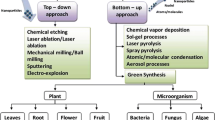Abstract
There is a demand for the development of environmental friendly methods for the synthesis of graphene composites. Reduced graphene oxide/silver (RGO/Ag) nanocomposites are very good catalysts. Here, we propose a simple, green method for the synthesis of RGO/Ag nanocomposite using the amino acid tyrosine as bioreductant and stabilizing agent. RGO/Ag nanocomposite was characterized by using various analytical techniques and studied for its catalytic degradation of 4-nitrophenol. Results of attenuated total reflectance Fourier transform infrared spectroscopy and Zeta potential at −55 mV reveal the surface capping of tyrosine onto the reduced graphene oxide nanosheets. RGO/Ag nanocomposites show excellent catalytic reduction of 4-nitrophenol with NaBH4, when compared to actual individual silver nanoparticles.




Similar content being viewed by others
References
Akhavan O, Ghaderi E (2012) Escherichia coli bacteria reduce graphene oxide to bactericidal graphene in a self-limiting manner. Carbon 50:1853–1860. doi:10.1016/j.carbon.2011.12.035
Ashraf S, Abbasi AZ, Pfeiffer C, Hussain SZ, Khalid ZM, Gil PR, Parak WJ, Hussain I (2013) Protein-mediated synthesis, pH-induced reversible agglomeration, toxicity and cellular interaction of silver nanoparticles. Colloids Surf B 102:511–518. doi:10.1016/j.colsurfb.2012.09.032
Chai L, Wang T, Zhang L, Wang H, Yang W, Dai S, Meng Y, Li X (2014) A Cu–m-phenylenediamine complex induced route to fabricate poly(m-phenylenediamine)/reduced graphene oxide hydrogel and its adsorption application. Carbon 81:748–757. doi:10.1016/j.carbon.2014.10.018
Geim AK, Novoselov KS (2007) The rise of graphene. Nat Mater 6:183–191. doi:10.1038/nmat1849
Hsu KC, Chen DH (2014) Green synthesis and synergistic catalytic effect of Ag/reduced grapheme oxide nanocomposites. Nanoscale Res Lett 9:1–10. doi:10.1186/1556-276X-9-484
Kim YK, Min DH (2012) Simultaneous reduction and functionalization of graphene oxide by polyallylamine for nanocomposite formation. Carbon Lett 13:29–33. doi:10.5714/CL.2012.13.1.029
Kuila T, Bose S, Khanra P, Mishra AK, Kim NH, Lee JH (2012) A green approach for the reduction of graphene oxide by wild carrot root. Carbon 50:914–921. doi:10.1016/j.carbon.2011.09.053
Li J, Xiao G, Chen C, Li R, Yan D (2013) Superior dispersions of reduced graphene oxide synthesized by using gallic acid as reductant and stabilizer. J Mater Chem 1:1481–1487. doi:10.1039/C2TA00638C
Maddinedi SB, Mandal BK (2014) Low-cost and eco-friendly green methods for graphene synthesis. Int J Nano Sci Technol 3:46–61
Maddinedi SB, Mandal BK (2015) Biofabrication of reduced graphene oxide nanosheets using terminalia bellirica fruit extract. Curr nanosci. 12:94–102. doi:10.2174/1573413711666150520224358
Maddinedi SB, Mandal BK, Vankayala R, Kalluru P, Tammina SK, Kiran Kumar HA (2014) Casein mediated green synthesis and decoration of reduced graphene oxide. Spectrochim. Acta Part A Mol Biomol Spectrosc 126:227–231. doi:10.1016/j.saa.2014.01.114
Maddinedi SB, Mandal BK, Ranjan S, Dasgupta N (2015a) Diastase assisted green synthesis of size controllable gold nanoparticles. RSC Adv 5:26727–26733. doi:10.1039/C5RA03117F
Maddinedi SB, Mandal BK, Vankayala R, Kalluru P, Pamanji SR (2015b) Bioinspired reduced graphene oxide nanosheets using Terminalia chebula seeds extract. Spectrochim Acta Part A 145:117–124. doi:10.1016/j.saa.2015.02.037
Maddinedi SB, Mandal BK, Patil SH, Andhalkar VV, Ranjan S, Dasgupta N (2017) Diastase induced green synthesis of bilayered reduced graphene oxide and its decoration with gold nanoparticles. J Photochem Photobiol B 166:252–258. doi:10.1016/j.jphotobiol.2016.12.008
Paredes JI, Rodil SV, Merino MJF, Guardia L, Alonso AM, Tascon JMD (2011) Environmentally friendly approaches toward the mass production of processable graphene from graphite oxide. J Mater Chem 21:298–306. doi:10.1039/C0JM01717E
Perera SD, Mariano RG, Nijem N, Chabal Y, Ferraris JP, Balkus KJ (2012) Alkaline deoxygenated graphene oxide for supercapacitor applications: an effective green alternative for chemically reduced graphene. J Power Sources 215:1–10. doi:10.1016/j.jpowsour.2012.04.059
Saraschandra N, Lakshmi Kumari P, Das RK, Sivakumar A, Patil SH, Andhalkar VV (2016) Amelioration of excision wounds by topical application of green synthesized, formulated silver and gold nanoparticles in albino Wistar rats. Mater Sci Eng C 62:293–300. doi:10.1016/j.msec.2016.01.069
Selvakannan PR, Swami A, Srisathiyanarayanan D, Shirude PS, Pasricha R, Mandale AB, Murali S (2004) Synthesis of aqueous Au core-Ag shell nanoparticles using tyrosine as a pH-dependent reducing agent and assembling phase-transferred silver nanoparticles at the air-water interface. Langmuir 20:7825. doi:10.1021/la049258j
Si Y, Samulski ET, Hill C, Carolina N (2008) Synthesis of water soluble graphene. Nano Lett 8:1679–1682. doi:10.1021/nl080604h
Stankovich S, Dikin DA, Piner RD, Kohlhaas KA, Kleinhammes A, Jia Y (2007) Synthesis of graphene-based nanosheets via chemical reduction of exfoliated graphite oxide. Carbon 45:1558–1565. doi:10.1016/j.carbon.2007.02.034
Thakur S, Karak N (2012) Green reduction of graphene oxide by aqueous phytoextracts. Carbon 50:5331–5339. doi:10.1016/j.carbon.2012.07.023
Wang G, Yang J, Park J, Gou X, Wang B, Liu H, Yao J (2008) Facile synthesis and characterization of graphene nanosheets. J Phys Chem C 112:8192–8195. doi:10.1021/jp710931h
Yeh CC, Chen DH (2014) Ni/reduced graphene oxide nanocomposite as a magnetically recoverable catalyst with near infrared photothermally enhanced activity. Appl Catal B Environ 150–151:298–304. doi:10.1016/j.apcatb.2013.12.040
Zhang YW, Liu S, Lu WB, Wang L, Tian JQ, Sun XP (2001) In situ green synthesis of Au nanostructures on graphene oxide and their application for catalytic reduction of 4-nitrophenol. Catal Sci Technol 1:1142–1144. doi:10.1039/C1CY00205H
Zhang L, Chai L, Duan J, Li G, Wang H, Yu W, Sang P (2011) One-step and cost-effective synthesis of micrometer-sized saw-like silver nanosheets by oil/water interfacial method. Mater Lett 65:1295–1298. doi:10.1016/j.matlet.2011.01.062
Zhang L, Wang T, Wang H, Meng Y, Yu W, Chai L (2013) Graphene@poly (m phenylenediamine) hydrogel fabricated by a facile post-synthesis assembly strategy. Chem Commun 49:9974–9976. doi:10.1039/C3CC45261A
Acknowledgements
Mr. SBM greatly acknowledges the help of VIT University, Vellore-632014, India for the financial help and platform given to do this research. Also, SBM acknowledges the help from Korean Basic Science Institute, Busan Center, Busan 618 230, South Korea for Transmission electron microscopy, X-ray photoelectron spectroscopy and FE-SEM facilities.
Author information
Authors and Affiliations
Corresponding author
Rights and permissions
About this article
Cite this article
Maddinedi, S.B., Mandal, B.K. & Fazlur-Rahman, N.K. High reduction of 4-nitrophenol using reduced graphene oxide/Ag synthesized with tyrosine. Environ Chem Lett 15, 467–474 (2017). https://doi.org/10.1007/s10311-017-0610-x
Received:
Accepted:
Published:
Issue Date:
DOI: https://doi.org/10.1007/s10311-017-0610-x




